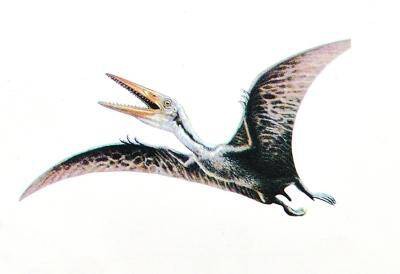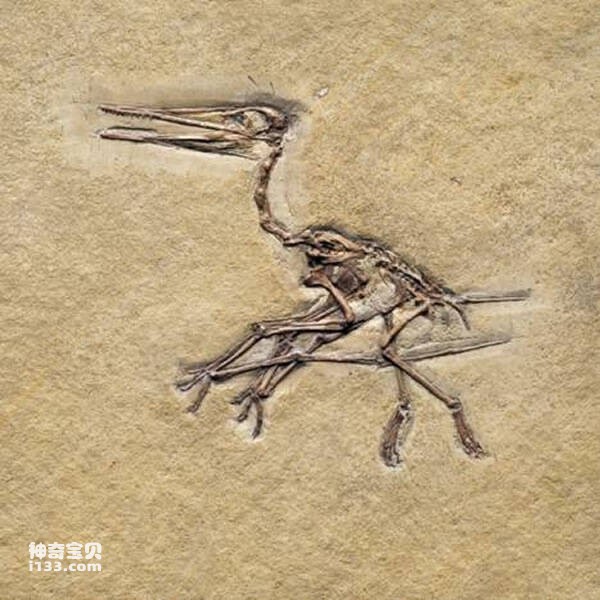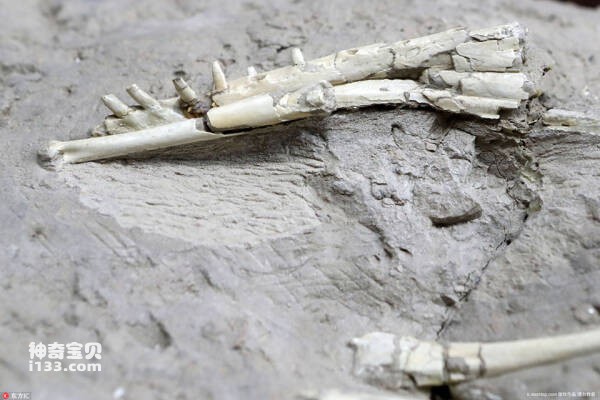1. History of pterosaur research
Pterosaurs were discovered about half a century earlier than dinosaurs, and they can be found on all continents around the world. As early as 1757 to 1784, the first pterosaur fossil was discovered in Solnhofen, Germany. When the Italian scholar Collini described the pterosaur fossil in 1784, he could not even determine what type of animal it belonged to. Some people Some people think that it lives in the ocean, and some people think that it is a transitional type between birds and bats. Some scientists have even asked whether pterosaurs are the "phoenix" in traditional Chinese culture. It was not until 1801 that the famous French anatomist Cuvier identified it as a pterodactyl and classified it as a reptile. And named this brand new creature "Pterodactyle". Later, these flying reptiles were collectively called "pterosaurs".
From the time Cuvier named the first pterosaur specimen to the present, scientists have discovered pterosaur fossils on every continent except Antarctica. Their research on pterosaurs involves almost all aspects of pterosaurs. These contents should not include the relationship between pterosaurs and other animals, appearance characteristics, what kind of geographical and ecological environment they live in, lifestyle, movement methods, feeding methods, reproduction methods, cold-blooded or hot-blooded, etc.

2. Chinese pterosaurs
The earliest pterosaur fossils discovered in my country are the Junggar pterosaur Weishi and Pterosaurus pterosaurs studied by the famous paleontologist Academician Yang Zhongjian. Junggar Pterosaur is a large pterosaur with wings spread up to 4 meters. Later, the Huanhe Pterosaur from Qingyang, Gansu Province, the Stenosaurus from Zigong, Sichuan Province, and the Zhejiang Pterosaur from Taizhou, Zhejiang Province were successively discovered.
Since the 1990s, a large number of pterosaur fossils have been discovered in the Jehol biota in western Liaoning, such as Pterosaurus Haosi, Pterosaurus sinensis, Feilong, etc. This area has also become the richest source of pterosaur fossils in the world. China's first pterosaur, Pterosaur Wei's Junggar from the Tugulu Group in the Junggar Basin, Xinjiang, China, is the earliest pterosaur fossil studied in China. The genus name Junggar is the origin of the fossil, and the species name Wei's was donated to the Exploration Office of the Xinjiang Petroleum Science Institute. Mr. Wei Jingming of the Paleontology Group, who handed these specimens to Mr. Yang Zhongjian of the Institute of Paleontology, Chinese Academy of Sciences, for research in the summer of 1963. A large number of these pterosaurs have been discovered in the Urho area in the northwest of the Junggar Basin in Xinjiang, and it is speculated that they lived in the Early Cretaceous. Pterosaurus weidensis is a relatively large pterosaur, with its wings spread up to more than 5 meters. The snout of its head is sharp, toothless, and curved upward. This is also an important sign that distinguishes it from other pterosaurs. However, What kind of prey is this special snout used for? It’s still confusing.

3. Evidence that pterosaurs are warm-blooded animals
At the beginning of the 20th century, British paleontologists believed that pterosaurs had the ability to move quickly, were like bats, had hair on their bodies, and had similar living habits to birds. Therefore, pterosaurs should be warm-blooded animals with a constant body temperature. Later, hair imprints were found on the rhynchophosaur fossils found in Germany. In 1970, a relatively complete pterosaur fossil with "hair" was discovered in Kazakhstan. British paleontologists studied the hairy and wing membrane structures of this specimen and believed that it was undoubtedly a warm-blooded pterosaur. animal. These "hairs" on the pterosaur's body insulate and maintain heat, prevent the loss of body heat, and have the function of regulating body temperature, which can directly prove that pterosaurs are warm-blooded and warm-blooded animals. Recently, the discovery of "Mao" Jehol pterosaurs in western Liaoning has further proved that at least some small pterosaurs are warm-blooded animals. Imprints of blood vessels that regulate body temperature were found on the massive head ridge of the Brazilian Seaskipper Pterosaur. Another piece of evidence comes from the fact that pterosaur bones had, like birds, small air sacs that regulate body temperature. These are direct evidence that pterosaurs are warm-blooded animals.

4. Pterosaur wings
The forelimbs of pterosaurs are highly specialized. The fourth finger is lengthened and thickened to become the flying wing digit. It is composed of four wing phalanges with no claws at the front end. Together with the forelimbs, it forms the strong front edge of the flying wing, supporting and connecting the sides of the body and the hind limbs. membranes, forming wing membranes similar to bird wings capable of flight. The pterosaur's wrist developed a unique wing bone that extended forward toward the shoulder, which supported the wing membrane. The first to third fingers grow on the outside of the wing membrane and become hook-shaped claws, and the fifth finger degenerates and disappears.
The wing membrane structure that supported the flight of pterosaurs was completely different from the wing structure of subsequent vertebrates that could fly - birds and bats. The wings of birds are equipped with feathers that are very effective for flight and body insulation. Although the wing membranes of bats do not have feathers, they have three phalanges as supports that play an important role in flapping their wings for flight. In addition to fibers distributed in the wing membrane of pterosaurs, there is no skeletal support. Therefore, the traditional view is that pterosaurs cannot soar freely and long distances in the blue sky like birds, and can only fly near their living environment. Such as gliding or hovering on the seaside, lakeside rocks or woods. However, the latest research on pterosaur brain CT scans and shoulder straps shows that pterosaurs were not only able to glide short distances, but also probably had powerful flight capabilities.
animal tags:
We created this article in conjunction with AI technology, then made sure it was fact-checked and edited by a Animals Top editor.